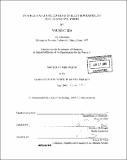Synthesis and applications of electron deficient conjugated polymers
Author(s)
Kim, Youngmi, Ph. D
DownloadFull printable version (8.746Mb)
Other Contributors
Massachusetts Institute of Technology. Dept. of Chemistry.
Advisor
Timothy M. Swager.
Terms of use
Metadata
Show full item recordAbstract
Chapter 1. In this introductory chapter, we present the general properties of conjugated polymers for sensory and electronic applications, with a special emphasis placed on electron-deficient materials. Chapter 2. In this chapter is presented the synthesis, characterization, and applications of a series of electron-deficient poly(p-phenylene vinylene)s (PPVs) homopolymers and copolymers. Poly(p-phenylenevinylene)s containing trifluoromethyl substituted aromatic rings (CF3- PPVs) exhibited high photooxidative stability to give robust materials suitable for molecular electronic device applications. Chapter 3. Hyperconjugative and Inductive Perturbations in Poly(p-phenylene vinylenes) New approaches that produce high fluorescence quantum yields and also tune electron affinity of conjugated polymers are presented. Novel three-dimensional poly(phenylene vinylenes) having [2.2.2] bicyclic ring system were synthesized to give highly efficient solid- state fluorescence and hyperconjugative and inductive electronic perturbations. The ability of hyperconjugative and inductive perturbation to tune the polymers' sensory applications was determined by investigating the fluorescence quenching responses to electron-rich and electron-deficient analytes in solution and solid thin films. Chapter 4. High Ionization Potential Conjugated Polymers In this chapter is presented a series of poly(p-phenylene ethynylenes) (PPEs) with high ionization potentials. Their photophysical properties were investigated using steady-state and time-resolved fluorescence techniques. (cont.) The ionization potentials of the polymer thin films were determined using ultraviolet photoelectron spectroscopy (UPS), and those with the highest ionization potentials displayed high sensitivity for the detection of electron-donating aromatic compounds. The effects of sterics and electronic properties on the polymers' sensory responses were investigated by fluorescence quenching experiments in both solution and solid thin films. In addition, in some cases the excited state charge-transfer complexes (exciplexes) of the PPEs with analytes were observed. These effects provide promising opportunities for the formation of sensitive and selective chemical sensors. Chapter 5. Highly Emissive Conjugated Polymer Excimers Conjugated polymers often display a decrease of fluorescence efficiency upon aggregation due in large part to enhanced interpolymer interactions that produce weakly emissive species generally described as having excimer character. We have found that poly(phenylene ethynylene)s with fused pendant [2.2.2] ring structures having alkene bridges substituted with two ester groups function to give highly emissive, broad, and red-shifted emission spectra in the solid state. To best understand the origin of this new solid-state emissive species, we have performed photophysical studies of a series of different materials in solution, spin-coated thin films, solid solutions, and Langmuir films. We conclude that the new, red-shifted, emissive species originate from excimers produced by interchain interactions being mediated by the particular [2.2.2] ring system employed. (cont.) The ability to predictably produce highly emissive excimers from conjugated polymers is important for the understanding how solid-state structures can control emissive behaviors. Chapter 6. Electron-Deficient Polyelectrolytes For Biosensory Applications In this chapter is described a novel photo-oxidizing water-soluble fluorescent polymer that was designed for the detection of electron-rich biological analytes. The polymer fluorescence is strongly quenched through an efficient photoinduced electron transfer from electron-donating aromatic moieties in amino acids, neurotransmitters, and proteins to the photo-oxidizing polymer. These efficient fluorescence quenching responses may be further enhanced by rapid exciton migration in the polymer backbone and further facilitated by ion- pairing between the polymer and quencher.
Description
Thesis (Ph. D.)--Massachusetts Institute of Technology, Dept. of Chemistry, 2005. Vita. Includes bibliographical references.
Date issued
2005Department
Massachusetts Institute of Technology. Department of ChemistryPublisher
Massachusetts Institute of Technology
Keywords
Chemistry.